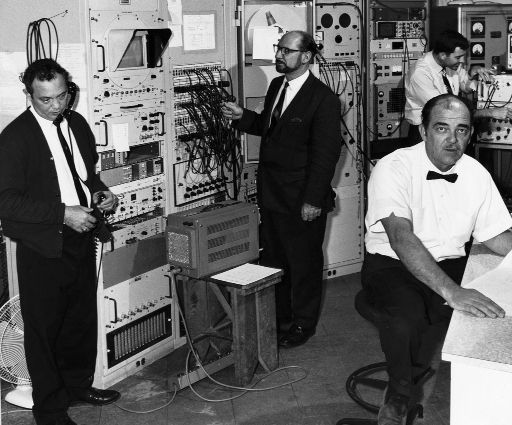 |
(L-R) Alfred Stella, George Kropp, William Reytar (back) and Robert Taylor (seated at front)
 |
(L-R) Alfred Stella, George Kropp, William Reytar (back) and Robert Taylor (seated at front)
Jasper Wall, a young PhD student at Parkes at the time, has remarked: "...they're all NASA personnel - you can tell because they are wearing ties".
Robert Taylor: Operations manager of the NASA effort at Parkes. A graduate of North Carolina State University. He had fourteen years experience in the heavy radar field - research, navigation and surveillance equipment - and supervision of equipment in naval bases, air stations and on ships. Taylor logged a million air miles on this work, concentrating on the Pacific region and as far north as Alaska. He was stationed in Japan from late 1956 to 1960. His base, at the time of Apollo 11, was the Goddard Spaceflight Centre, where he had been attached for four years. His division came under the control of the Manned Flight Support Director, whose engineering division had four key branches, one of which specialised in tracking and data relay - the work undertaken at Parkes.
George Kropp: A specialist in unified S-band and separation equipment used in Apollo communications. An electrical engineer with a great deal of experience in the computer field. His work was usually at the launch site at Cape Kennedy, with teams supporting the Apollo missions. He was employed by Bendix Field Engineering which was contracted by NASA for the support service.
Alfred Stella: Magnetic tape recording and television monitoring expert. He graduated from New Hampshire Technical Institute in 1955. He joined the military space programme in Florida in 1956, and remained until 1960. His first mission with NASA was on the Gemini programme, being with the launch crew in charge of ground instrumentation. He joined the Apollo programme in 1966. He was on his first trip to Australia.
William Reytar: Graduated B.S. in Electrical Engineering from Virginia Polytechnic Institute in 1962. Joined Westinghouse and then went to NASA in 1966. His work was on receiver equipment, which he built since February 1969, in a "crash programme" for the Parkes part in the Apollo 11 lunar landing mission. He was on his third trip to Australia.